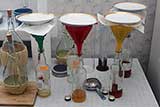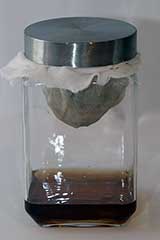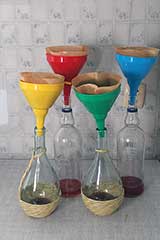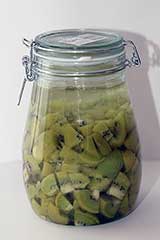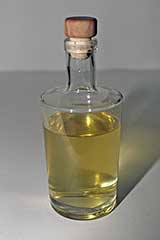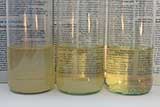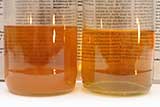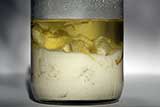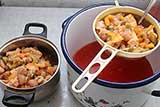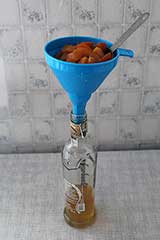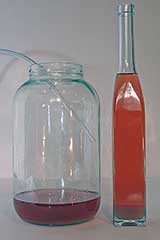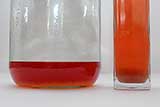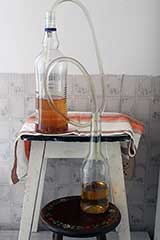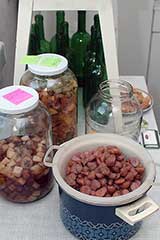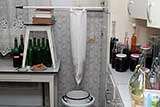Meats and Sausages
Homemade Infusions
Traditional home production of infusions calls for adding sugar, water, and alcohol to fruit at the same time. After 3 weeks of maceration time, the infusion is siphoned off and left to age for a few months. The longer the better; there is no risk of spoiling as alcohol preserves infusion. Then it is re-checked for clarity, carefully siphoned and poured into bottles. In a worst case scenario it may have to be filtered before bottling. Homemade infusions usually employ the first immersion method to save time and space. If space is of little concern and a large amount of fruit is available, much more infusion will be produced when the second immersion is employed. In such a case the first infusion is often made without sugar.
- First infusion is made without sugar.
- Sugar and alcohol are added to the fruit (the second infusion).
- Both infusions are then combined.
After the first or the second infusion ends there is still a certain amount of juice and alcohol that remains in the fruit. It can be filtered through a cheese cloth or gauze. Don't squeeze the mash; let gravity take its course.
The best of the fruit is removed by the first infusion and combining both infusions will create a lower quality product. It is advisable to keep both batches separately as two distinct products. A smart solution is to add essential oil at 0.1 g per 10 liters to the second infusion to enhance its flavor. Often the first infusion is made with alcohol only. After macerating, the infusion is filtered and kept for future use. However, sugar and some alcohol is added to fruit leftovers and left to macerate again. Then it is filtered and bottled as a separate infusion. Almost all traditional recipes are made in this manner:
- Fruit preparation.
- Adding sugar.
- Adding alcohol.
- Macerating.
- Pouring off/filtering.
- Aging.
This is a fine method and a great infusion can be produced. The factory model offers more benefits:
- Infusion can be stored as a raw material. Sugar will be added when the composition of the infusion is determined.
- It is easier to calculate the infusion's alcoholic strength and its sugar content.
- Filtering is easier as the infusion is generally thinner.
Commercial producers perform macerating without sugar. Infusion becomes a ready to use material, one of many components of a flavored spirit that will be made. Sugar or syrup is added when the final blending takes place. The maximum time for creating infusions is 4-6 weeks, otherwise the quality becomes lower. Usually, 3-4 weeks is all that is needed.
Filtering
Filtering is the step that gives the final touch to your master piece. It makes it clear and aesthetically pleasing.
Infusions if left undisturbed, should clarify themselves with bigger particles of fruit settling down on the bottom. Then siphoning the liquid with a plastic wine tube will do the trick. The sediment can also be filtered by running it through a filter. It is a very slow process and the container should be well covered in order to protect alcohol from evaporating. Fruits that contain a lot of pectin, like lemons, have a tendency to produce cloudy liquids. Most people use a funnel that is lined with a paper towel, coffee filter, medical gauze, cheese cloth or even make up removing pads.
Using one funnel can be a slow and tedious operation which can be improved by simply using more funnels. Pour the infusion through a strainer into each filter and the operation will be faster. Paper towels filter well and they are disposable which makes them easy to use. Nylon cheese cloth is a great filter material that is easy to wash. Certain fruits such as sour cherries or kiwi produce clear juices while others like lemon or plums appear cloudier.
You can use any kind of filtering system, but the following method works very well:
- 1. Strain the infusion through a fine sieve. You can use the fruit for making the second infusion.
- 2. Pour the infusion into a tall bottle. Let the infusion sit for one or two days. All bigger particles will sink to the bottom and a clear liquid will form on top.
3. Siphon the clear liquid away. It is difficult to siphon a small amount of infusion, for example 500 ml, that remains in a large jar. In such cases it is recommended to use a tall but small diameter container.
Infusions which are made with fruit and alcohol only tend to filter easily. When a significant amount of sugar is present, filtering becomes hard. A simplified "racking" process works faster and better. Racking is the term used for filtering wine. Fermented wine, even if it was made from fresh juice, contains little parts of fruit and dead yeast. All those particles sink to the bottom creating a layer of sediment. The clear wine is siphoned away to another container and left again for a month. Then it is siphoned again. At the end only clear wine remains.
Don't disturb a strained infusion before filtering. Try to siphon the clear liquid first, and run the rest through the filter. Combine liquids together and filter again. Ratafia infusions are made in larger quantities and to filter 10- 20 liters of freshly made infusion will take too long using small equipment. Use a big filtering bag and a suitable vessel. Strain the liquid first through a strainer, then place the leftover fruit in a big filter bag and let it drip over nigh t.Then combine liquids together and filter again. You don't need much space or specialized equipment to produce 10 liters of ratafia. What's important is the proper organization and workflow.

